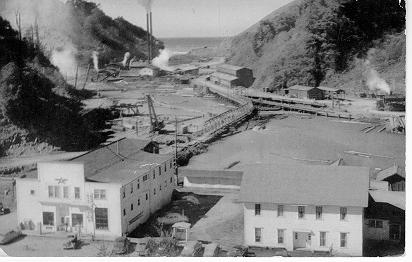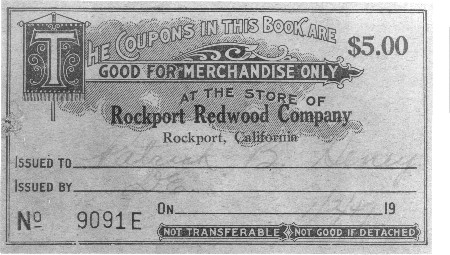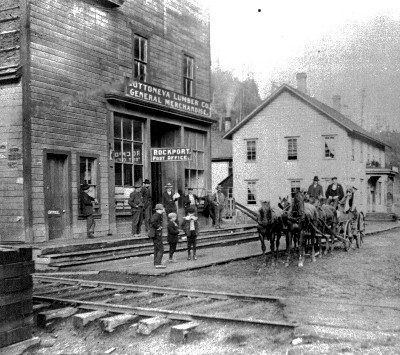|
 Fifty years ago, James Allen made a pioneering
effort to study company towns in western United States.
He was interested in how company towns developed, what
industries spawned them, what the advantages and disadvantages
of these towns were for the companies and for the employees,
how they affected the economic and social history of
America, and why they are disappearing. Some of these
towns were coal-mining towns, oil towns, and, of course,
lumber towns. "A dramatic
illustration of the changing patterns of the lumber
industry and its effect upon company towns," writes
James Allen, "is seen in the story of Rockport, California"
(Allen, 25). Fifty years ago, James Allen made a pioneering
effort to study company towns in western United States.
He was interested in how company towns developed, what
industries spawned them, what the advantages and disadvantages
of these towns were for the companies and for the employees,
how they affected the economic and social history of
America, and why they are disappearing. Some of these
towns were coal-mining towns, oil towns, and, of course,
lumber towns. "A dramatic
illustration of the changing patterns of the lumber
industry and its effect upon company towns," writes
James Allen, "is seen in the story of Rockport, California"
(Allen, 25).
About 25 miles north of
Fort Bragg on the rocky Mendocino coast, Rockport, also
known at one time as Cottoneva, began as a lumber camp.
With its mill right on the coast, timber could be shipped
directly south to San Francisco. When Rockport Redwood
Company closed the mill in 1957, the population of Rockport
was about 500 (Allen, 25).The town included a company
store, a community town hall, and a company doctor,
in addition to employee housing. The linked map (jpeg 4 MB) shows the layout
of the town as it appeared in 1945; use a digital imaging
program to enlarge and view the detail. Today only a
few of the original houses remain. One of them, remodeled
and called the Rockport guest house, is used by
MRC employees as a vacation retreat.
"The rise and decline of the town
of Rockport," Allen concludes, "uniquely demonstrates
the evolution of the lumber industry, from the early
days of a cutting and shipping operation to the present
management of sustained-yield forests" (Allen, 25).
He adds that the consolidation and development of large
timber corporations may be a third factor in the elimination
of company lumber towns. The emerging corporations,
not wanting to get involved in community management
and services (like overseeing water, sewers, street
lighting, police protection, routine medical care, and
road maintenance) urged employees to purchase homes
in nearby towns and relegated the company logging town
to oblivion. Of course, there were much larger social
impacts at play as well. John Kenneth Galbraith (1958)
coined the term "the affluent society" to describe Americans
after World War II. As part of that affluence, more
Americans had access to automobiles and a growing span
of highway. They quickly fell in love with drive-in
movies, drive-in restaurants, shopping malls, suburbs,
and Sunday drives in the country. Moreover before World War II, few
women had careers; their traditional role was wife,
mother, and homemaker. Those who did work outside the
home were generally secretaries, nurses, and teachers.
However, with millions of men needed for the war effort,
women took their place in weapons factories, offices,
and stores; they became machinists, railroad engineers,
and lumberjacks. At the same time, labor unions
steadily organized workers
in industry after industry, giving them, for the first
time, power in negotiations with company owners.
With new mobility, larger
aspirations, and bigger paychecks, many found there was much
more to life than just the company town. Interestingly,
Tennessee Ernie Ford released a record in 1955 of a Merle
Travis song about a coal mining town, "Sixteen Tons," with
this soulful refrain:
|
You
load sixteen tons an' what do you get?
Another day
older an' deeper in debt.
St Peter don't you call me
'cause I can't go:
I owe my soul to the company
store. |
In 11 days this flip-side single
sold 400,000 records; in 24 days, 1 million copies;
and in less than 2 months, 2 million copies. At the
time it was the fastest-selling single in the history
of Capitol Records. Clearly this song that even its
producers did not expect to be a hit resonated with
many Americans. Often workers in company towns, like
Rockport, received advances against their salaries with
"scrips" that could only be redeemed at the company
store. Bernie Agrons, the last general manager of Rockport
Redwood Company, talks in a 2007 interview about the
Rockport company store in the mid-1950s ( wmv 4 MB). At that
time, Jimmy Foreman, who lived with his wife Alice in
one of the Rockport staff houses, was the store manager
and butcher. wmv 4 MB). At that
time, Jimmy Foreman, who lived with his wife Alice in
one of the Rockport staff houses, was the store manager
and butcher.

By the 1950s, the timber
industry and its workers had changed, along with American
society and attitudes. The big timber corporations no longer
needed to create company towns in isolated areas in order to
keep a workforce and many employees no longer wanted to live a
company life. Apart from its importance as a company town,
Rockport illustrates the perils and uncertainty of timber
investors.and timber workers. With its ups and downs, its
natural and financial disasters,its transfer from one owner to
the next, from small landowners to out-of-town corporations,
Rockport's story is reminiscent of many in Mendocino
County.
According to records on file at
the Bancroft Library, the first sawmill at Rockport
was built by William R. Miller around 1877. With a double
circular saw, edger, and planer, the mill had a daily
capacity of 20,000 board feet (Timberbeast,18). One
of the outstanding features at the mill site was a 270
ft wire suspension bridge,built in 1877 by Pacific Bridge
Company of San Francisco, that reached from the shore
to a small islet in the ocean, sometimes referred to
as Pelican Island. Logs were transported by rail to
this islet for loading on ships bound for San Francisco.
 When he retired in 1886, Miller
sold the mill to the Cottoneva Lumber Company. That
mill was eventually destroyed by fire in 1900. Around
1907, the Dusenbury family, who owned the New York and
Pennsylvania Redwood Company, acquired Cottoneva. They
planned to build a new mill at Rockport but their plans
never materialized. By 1925 Finkbine-Guild Lumber Company
out of Jackson, Mississippi bought Cottoneva Lumber
Company. Facing financial ruin, they too abandoned operations
in 1927 and their assets were acquired by the Great
Southern Lumber Company of Bogalusa, Louisiana to form
the Southern Redwood Company. When he retired in 1886, Miller
sold the mill to the Cottoneva Lumber Company. That
mill was eventually destroyed by fire in 1900. Around
1907, the Dusenbury family, who owned the New York and
Pennsylvania Redwood Company, acquired Cottoneva. They
planned to build a new mill at Rockport but their plans
never materialized. By 1925 Finkbine-Guild Lumber Company
out of Jackson, Mississippi bought Cottoneva Lumber
Company. Facing financial ruin, they too abandoned operations
in 1927 and their assets were acquired by the Great
Southern Lumber Company of Bogalusa, Louisiana to form
the Southern Redwood Company.
Within two years, Southern
Redwood Company also shutdown. In 1933 the Dusenbury family
foreclosed on the original defaulted bonds of Finkbine-Guild
and chartered the Cottaneva Redwood Company. Ralph Rounds of
Wichita, Kansas, in 1937, took a lease to operate the
Cottaneva Redwood Company. The company was renamed Rockport
Redwood Company in 1941. Operations at that time included a
sawmill, a company town, and approximately 36,000 acres of
timberland. The Rockport mill finally fell to competition and
closed its doors in 1957. Following Rounds death in 1960, the
mill was dismantled and auctioned off. That same year, the
Rockport Redwood Company certified the timberlands as the
Ralph M. Rounds Tree Farm, selling timber to neighboring
companies. The term "tree farm" originated two decades earlier
in the 1940s, as the timber industry introduced the concept of
sustainable forestry and continual stewardship. Farming
implies continuous nurturing and commitment to a "crop" year
after year. Tree farming was the polar opposite of the
"cut-out and get-out" strategy of some timber
industrialist.
Ralph C. Round, the elder's
heir, sold the Ralph M. Rounds Tree Farm and the town of
Rockport to Georgia-Pacific on July 30, 1968. In 1973 the
Rounds Tree Farm, the Georgia-Pacific timberlands throughout
northern California, and the former town of Rockport was spun
off into Louisiana-Pacific. MRC purchased the
Louisiana-Pacific lands, including the Rockport townsite, in
1998.
Author:
DMS
Primary
Source
Rockport Redwood Company
Records, BANC MSS 70/184 c, The Bancroft Library (Berkeley,
CA).
Secondary
Sources
Allen, James B. The Company Town
in the American West. Oklahoma: University of Oklahoma Press,
1966.
Columbia River and Pacific
Northwest Timberbeast, Pacific Lumber No. 29.
Westport. Mendocino Historical
Review (Summer 1978), vol. 4, number
4.
Photo
Credits
Rockport Mill,
Robert J. Lee Collection,
Held-Poage Research Library (Ukiah, CA).
Rockport coupon book,
Robert J. Lee Collection.
Cottoneva Hotel (c.
1900), Robert J. Lee Collection, Held-Poage Research Library
(Ukiah, CA).
Photo Links
Rockport guest house,
photo by Doris M. Schoenhoff (2005).
Rockport suspension bridge and rails.
Robert J. Lee Collection (Ukiah, CA).
Video
Video interview of Bernie Agrons, Rockport Guest
House, 6 May 2007, conducted by Doris M.
Schoenhoff.
Linked Map
A copy of the 1945 flood map of Rockport was
discovered (2007) in the MRC vault by Roger Krueger, an MRC
consultant. |